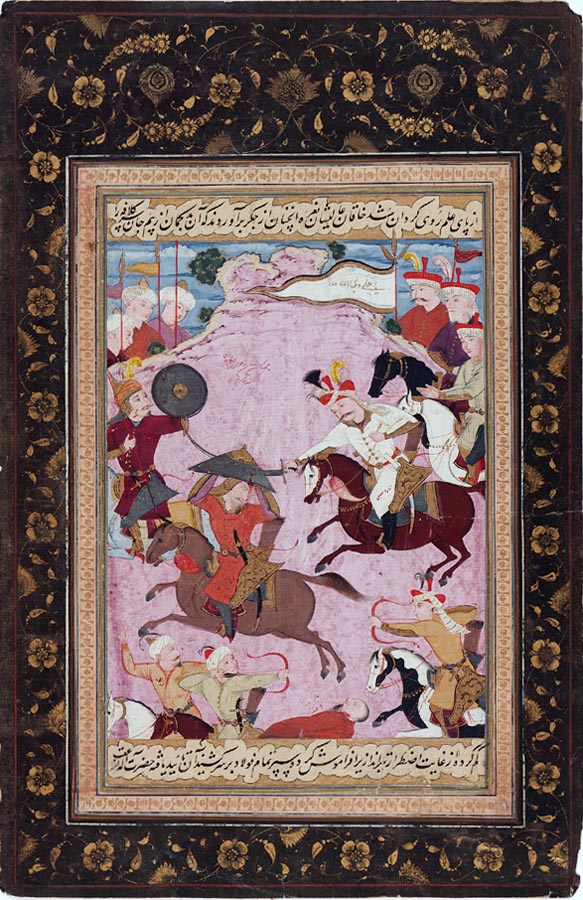Shah Esmāʿil Kills Abuʾl Ḵeyr Khan in Battle
Location: Freer Gallery of Art, Snithsonian Institution, Acc#F2000.3
Mount: Black mount with gold decoration 35.9 x 23.5 cm; buff collar.
Written surface: 23.6 x 15.1 cm.
Painting: 20.0 x 15.1 cm.
Text references: J.K., p.463 line 16 to p.464 line 2.
Morton, Pembroke_1990, pp192-96.
Date of this alleged event: 919/Summer 1513.
As Morton has elaborated in much detail, Esmāʿil's second campaign in Khorasan was
rather lackluster. When the Safavid forces approached Khorasan, the Uzbegs withdrew across the Oxus into Transoxiana and no major battles were fought between them. This makes for poor reading, so it appears that the compilers of the later anonymous histories of Esmāʿil saw fit to add some excitement. They created a a whole backdrop scenario, and added a major battle to the campaign in which Esmāʿil gets the chance to cut down the leader of a vast Qazāk-Uzbeg army, Abuʾl Ḵeyr Khan. Qāsem Khan was a very real person, and he may have had a son named Abuʾl Ḵeyr Khan, but there is no evidence that he existed in this time frame.
The place is somewhere in Khorasan, and the principal combatants are Shah Esmāʿil and the Uzbeg Abuʾl Ḵeyr Khan, alleged son of Qāsem Khan (see ms.M folio 273v). Across the center, moving from right to left, Shah Esmāʿil is pursuing his adversary. The shah wears a gold trimmed white coat, and red and white flat-top qezelbāsh tāj on his head. Leaning forward in the saddle with his right arm fully extended, he thrusts his sword at his opponent. Abuʾl Ḵeyr Khan defends himself with his shield, but his efforts have been to no avail - the awesome power of the shah’s sword has split the shield and helmet, and blood gushes forth from his head. On the far right are three mounted ḡāzis, while in the lower right another rides forward intently firing arrows at the fleeing Uzbegs. Two Uzbegs on the left foreground return the fire; on the ground between them lies a dead Uzbeg. Alongside of Abuʾl Ḵeyr Khan is another Uzbeg, with pointed helmet and brandishing a lance and shield, who turns to the rear as he rides out of the picture. The heads and shoulders of three additional Uzbegs, wearing turbans and armed with lances, appear beyond the ridge in the upper left. Customary with most of the other paintings, the event is depicted on a hillside simply rendered in a light mauve, which rises to a craggy rock formation near the top. On the ridge are several small suggestions of vegetation.
Cf. ms L, folio 232 and ms.M, folio 280 for two other versions of this painting also illustrated by Moʿin. Although there are considerable differences between this painting and the two other variants, that they are mutually influenced is certain. Yet, they are not slavish imitations of one another. This painting is not signed, but clearly in the style of Moʿin. Three inscriptions, possibly of later date, appear on the illustration. Two identify Shah Esmāʿil and Abuʾl Ḵeyr Khan repectively. Under the name of the latter are what appears to be numerals which are illegible. The third inscription, above the head of Abuʾl Ḵeyr Khan, describes the event.
Painting references:
Unpublished.
Provenence:
Formerly in the Collection of Mrs. A. Hyatt Mayor, New York
Photo courtesy of the Freer Gallery of Art & Athur M. Sackler Gallery.
Gift of Martha Mayor Smith and Alford Mayor in Memory of A. Hyatt Mayor.
Robert Eng
Last Updated: August 1, 2011 | Originally published: August 1, 2011
